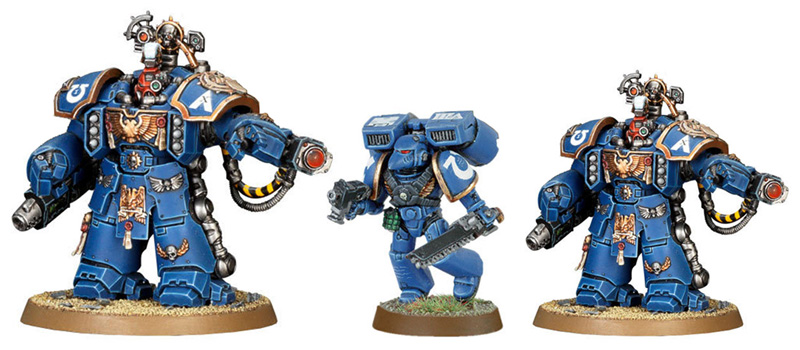The Hard Lesson of Games Workshop
This blog deals with the tabletop gaming company Games workshop and the predicament they have found themselves in with their players. In their story is a lesson all studios should take to heart.

The venerable table-top gaming titan is facing hard times. Turns out that, in the grim darkness of 2014, things are not looking well for the Imperium of Games Workshop. With lower than projected earnings for the year and a fierce internal inconsistency in company ethos, Games Workshop is on the verge of an exposure moment. The old way of running things at GW is no longer sufficient, and they must adapt or risk losing their long standing fanbase. In GW’s tale is a lesson that all game companies, in fact all creative enterprises, should take to heart.
All gamers, across every console from every generation, owe at the very least a debt of acknowledgement to Games Workshop. A tip of the hat, so to speak. Founded in the mid-70s, few other game companies can be said to have had such a wide-ranging influence without ever becoming the household name of the IPs it inspired. What would Starcraft be without the tome-spanning history of the Space Marines, Tyranids, and Eldar? Warhammer 40k was doing guns with chainsaws attached to them 30 years before Gears of War was even a thought spark at Epic. If a game has to do with war in the future, odds are Warhammer 40k has it covered somewhere in its hundreds of pages of lore and history, probably splattered with the gore of a chaos horror.
This year, GW celebrates its 40th anniversary as a company. It’s had a long, bumpy ride, weathering the storm of TCGs, video games, and the realities of being a niche game company in what is now becoming a highly competitive market. Boutique model companies and smaller, smarter games like X-Wing and Warmachine/Hordes are challenging GW on both fronts: as a model maker and as a tabletop games company. The proof is readily apparent. The last few quarterly reports to be released out of GW’s Nottingham headquarters show continually flagging profits on nearly all fronts while its competitors thrive. Even Warhammer Fantasy, progenitor even to WH40k, generally stands at between 7th and 9th for best-selling product according to their own metrics. And depite a mild uptick recently giving some hope, something is wrong here.
GW's strategy so far to combat this downward spiral has been to reduce customer value by overcharging for models (while reducing the total number of models per box), releasing rulebooks without properly tested rules, and segmenting their own product lines in an (apparent) attempt to make the game as inaccessible as possible. There is no other company of GW’s caliber in the world (that I am aware of) that acts the way they do in terms of their customers. To put them in perspective, they’re like EA on crack, selling rulebook add-ons called ‘dataslates’ for upwards of 15 dollars. That’s 15 dollars for 4 pages of rules and some fluff to supplement a 90 page book that only had 20 or so pages worth of rules to begin with. It’s a level of arrogance and disrespect for the players that, if GW were a videogame company, would be intolerable to the average gamer.
Identity Crisis
Games Workshop has said that, despite the name, it is the models that come first. The sculptors presumably work with the loremasters to figure out what they want to do, build a few prototypes, then they try to fit the new models into the army they were made for. It’s what led to this being made:

Yes, it’s a guy wearing a massive suit of armor, wearing another massive suit of armor on top of that. And as the cherry on top, the army this unit was made for already has a unit that serves the same purpose as a hard-hitting, walking tank: the Dreadnought. In the Centurion is every sin committed by GW against its players: a model no one really wanted, filling a role for which a unit already exists. It is so very Warhammer 40k it hurts.
Games Workshop has stated time and time again that their game was not designed to be competitive. That’s fine, Smash Bros. Melee wasn’t designed to be competitive and it’s one of the most watched fighting games in the world, easy for people to enter, hard to master. Warhammer 40k, by comparison, is neither easy to enter nor balanced at any particular level of play. Given GW’s release schedule, some armies have become so hopelessly outdated in terms of rulebooks that they literally cannot win against certain other army compositions. New campaign books get released while the actual armies languish. Fantasy is even worse, the Bretonnian army hasn't had either a model or rulebook update in 11 years.
Again, this wouldn’t be that bad, Smash Bros. Melee only has about 6 characters who are really viable in higher level play. It’s the kind of gameplay that they force players to adopt that is destroying the fun of the game. The one thread I constantly see repeated on Warseer, on Bell of Lost Souls, on Miniwargaming, is that players would want to buy more if the game were actually fun to play. They would try harder to get their friends into it if they had fun playing with the armies they loved. Games Workshop is a company where the Games part is what’s driving away players. Funny, that this ire is directed at a company that's on track to release over a dozen supplemental rulebooks this year alone.
The current meta-game revolves around shooting armies. Combat in Warhammer 40k is mostly shooting with a few brutal melee phases for those armies that specialize in getting close and wreaking havoc. Ideally the game would be a close duel of generalship, lots of movement, calculated risks, with risk management ultimately winning out over pure brute force. What the game actually is a blob of units parking themselves behind some defenses, barely moving, and chucking plasma at each other until one army falls over. The worst offenders of this are the ‘Deathstars’, clusters of units whose compounding buffs make them nearly invincible to all but the most broken, gamey armies.
This has been the state of the game since at least 2010, and it has only grown to the point where it’s difficult to go on any forum dedicated to 40k that doesn’t devolve into a sounding board for frustrated players to air their grievances. And then GW wonders what they could possibly do to save their dwindling user base. This all adds up to a terrible case of identity crisis, one that's harmful to the gamers and to the reputation of Games Workshop. Their products are beautiful as pieces of art, terrible as pieces on a game board.
What's most saddening about all this is that Games Workshop, despite what they might think, are brilliantly positioned to be a thriving, growing company. There’s a reason GW has survived for 40 years, and it’s because there are three aspects to their main product that no other company in the world can match in full. They have one of the deepest, most epic universes ever created, they are matched in model-making skill and resources only by small boutiques like Kingdom: Death, and they've had rulesets that (at least at one time) made playing with the models exceptionally fun.
Invulnerability Save
Now, GW, humor me for a brief moment. Scrap the rules you've got. Cut out all the garbage. Start fresh. Something simple and fast that keep the dice flying fast, plastic army men dying on all sides, tanks exploding, alien horrors being slain. Think about drama. Your players are going to be spending dozens of hours poring over their army, battles better unfold like the miniature Götterdämmerungs they are. Keep testing until every army has the power to earn a place at the Emperor's side. Give us that.
But why stop there? In my ideal world, I would expand GW to Toys-R-Us and WalMart and finally give what so many people have always wanted. For the longest time I've seen players turn away from GW, and tabletop games in general, simply because of the barriers that need to be overcome. If GW really wants to thrive, they should look to the unfulfilled players lurking just at the periphery. I'm talking about the kids and teens who scoop up boosters of HeroClix and will fight each other tooth and nail over the latest X-Wing miniatures expansion. Add a box set of three space marines, pre-painted and pre-based, being sold next to a big, beautiful showcase of a 41st Millennium battlefield and your fortunes would be reversed in a year.
The Big Takeaways
Ultimately, GW’s current predicament can be chalked up to a simple lack of really trying to give their players what they want. GW has the resources to address nearly every issue that players are currently experiencing with the game, they simply need to implement them. There is no shortage of veteran players who have proven that they both understand the game at a deeply mechanical level and can work professionally (the biggest trip-up when any company works with fans, I’ve noticed) that would jump at the chance to work with GW to reform their game system.
This is key moment for them to pivot, to say that they’ve made mistakes in the past but that now they’ve decided to fix them. Instead of pushing out another fluff novel or supplement for some obscure daemonic warband, bring the game back to life. It's what the Emperor would want.
Read more about:
BlogsAbout the Author(s)
You May Also Like








